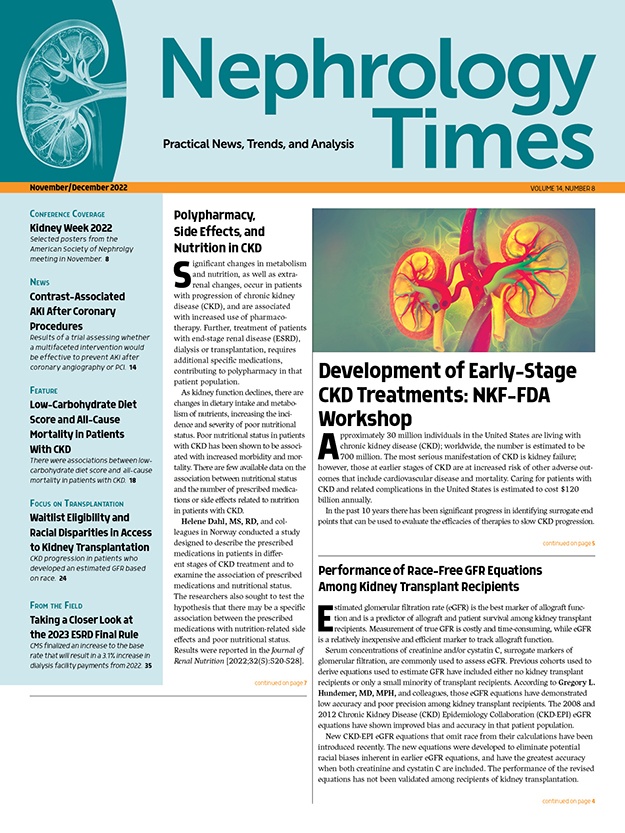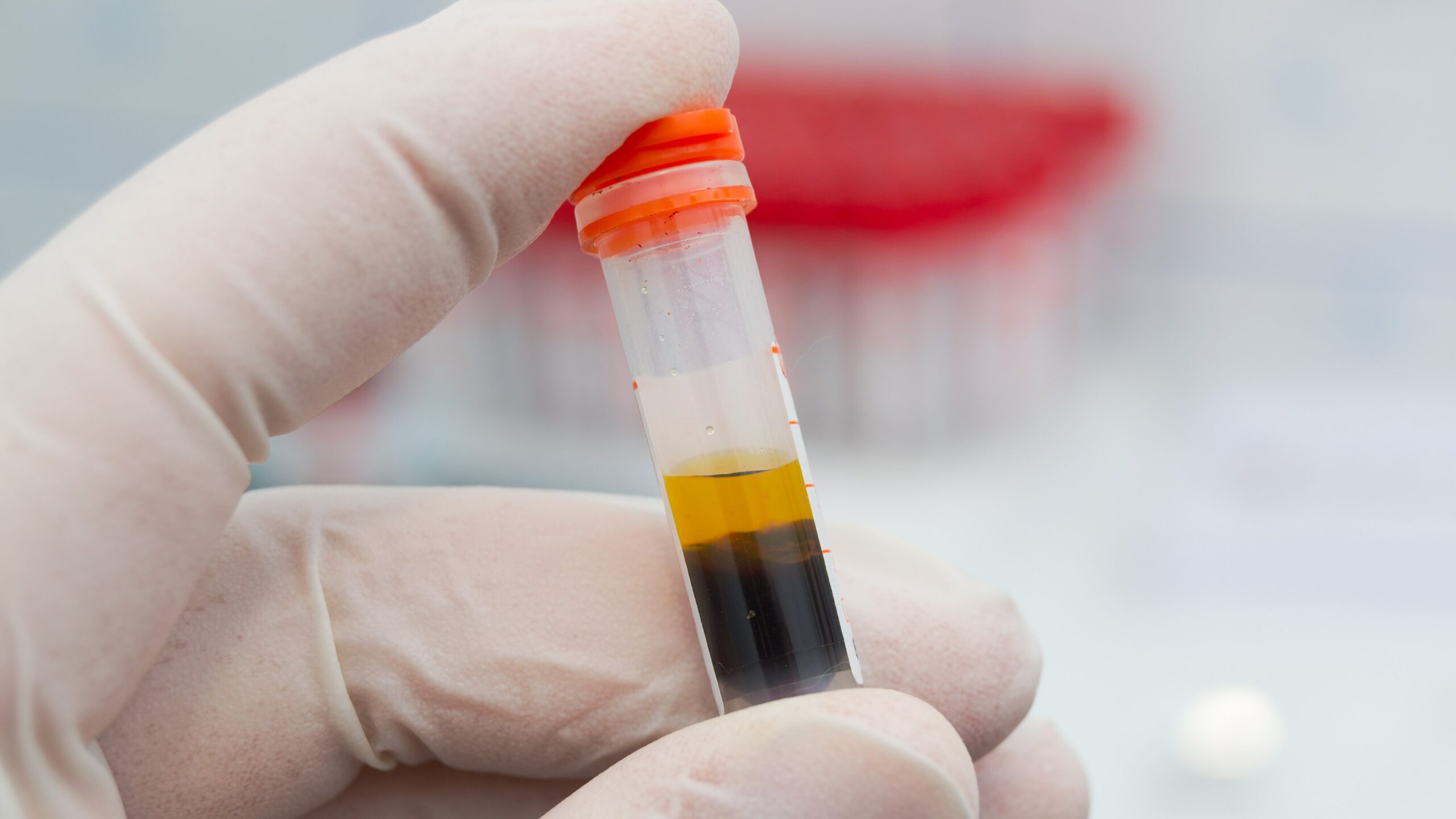
The optimal treatment for those with kidney disease at risk of kidney failure is kidney transplantation. Transplantation policy in the United States requires a glomerular filtration rate (GFR) ≤20 mL/min/1.73 m2 for activation on the kidney transplant list for all patients. However, according to Chi D. Chu, MD, MAS, and colleagues, this policy is at odds with a higher rate of chronic kidney disease (CKD) progression among persons of color.
Due to the use of commonly used serum creatinine-based equations for estimated GFR (eGFR) that incorporate a race term that assigns higher eGFR to Black patients, there are concerns that the use of those equations may be associated with delayed waitlisting, thus contributing to racial disparities in access to kidney transplantation.
Both the Modification of Diet in Renal Disease Study and the CKD Epidemiology Collaboration (CKD-EPI) creatinine equation incorporate race terms that result in 21% or 16% higher eGFR, respectively, for Black patients compared with non-Black patients. Apart from ethical considerations of using race, which is not a biological construct, in a model that drives clinical decisions, there are also concerns that higher eGFR may delay access to various aspects of kidney care, including transplantation.
Dr. Chu et al conducted a retrospective cohort study to compare time from meeting transplant eligibility threshold of eGFR ≤20 mL/min/1.73 m2 to kidney failure with replacement therapy (KFRT) among Black, Hispanic, and White patients and to examine the impact of incorporating race into eGFR expressions on establishment of eligibility for waitlisting and time from eligibility to KFRT. Results were reported in the American Journal of Kidney Diseases [2022;79(6):841-848].
The researchers utilized the OptumLabs Data Warehouse to assemble a cohort of patients 18 to 75 years of age with an outpatient eGFR decrease to ≤20 mL/min/1.73 m2 from January 1, 2008, to December 31, 2018 (ie, patients having an outpatient eGFR value of ≤20 mL/min/1.73 m2 during the study with at least one earlier value between 20 and 60 mL/min.1.73 m2 within the preceding 2 years).
The total cohort included 52,130 patients; of those, 40,042 were non-Hispanic White, 8519 were non-Hispanic Black, and 3569 were Hispanic. When the cohort derivation was repeated assigning Black patients the eGFR CKD-EPI non-Black (eGFRnon-Black) value, it resulted in a cohort of 11,269 Black patients with an outpatient eGFRnon-Black decline to <20 mL/min/1.73 m2 during the study period.
At the time of incident eGFR <20 mL/min/1.73 m2, non-Hispanic White patients were older (mean age 64 years) compared with non-Hispanic Black or Hispanic patients who were on average 3 to 6 years younger. Non-Hispanic White patients on average had lower blood pressure compared with non-Hispanic Black and Hispanic patients (mean blood pressure 127/70 vs 135/76 and 135/73 mm Hg, respectively). Median urinary albumin-creatinine ratio was higher among non-Hispanic Black patients (672 mg/g) and Hispanic patients (247 mg/g) than among non-Hispanic White patients (133 mg/g).
During median follow-up of 24 months, there were a total of 18,002 KFRT events; of those, 9401 were among non-Hispanic White patients, 3411 were among non-Hispanic Black patients using eGFRBlack, 3718 among non-Hispanic Black patients using eGFRnon-Black, and 1472 among Hispanic patients. The number of deaths was 13,532 among non-Hispanic White patients, 1849 among non-Hispanic Black patients using eGFRBlack, 2577 among non-Hispanic Black patients using eGFRnon-Black, and 490 among Hispanic patients.
Regardless of how eGFR was calculated among Black patients, they were substantially more likely to progress to KFRT than non-Hispanic White patients; Hispanic patients were also more likely to progress to KFRT than non-Hispanic White patients.
By 3 years of follow-up, the risk of KFRT among non-Hispanic Black patients using eGFRBlack and the Hispanic cohorts was 36.0% (95% CI, 34.9%-37.0%) and 40.9% (95% CI, 39.0%-42.7%), respectively, compared with non-Hispanic White patients, who had a KFRT risk of 20.5% (95% CI, 20.0%-20.9%). When the eGFRnon-Black value was used, the disparity was modestly attenuated (KFRT risk over 3 years, 28.7%; 95% CI, 27.8%-29.6%).
In unadjusted analyses, non-Hispanic Black patients using eGFRnon-Black and Hispanic patients had a 1.51-fold (95% CI, 1.46-1.56) and 2.25-fold (95% CI, 2.13-2.38), respectively, increased hazard of KFRT. Following multivariable adjustment, the increased risk of KFRT was attenuated but remained statistically significant among non-Hispanic Black (hazard ratio [HR], 1.28; 95% CI, 1.15-1.43) and Hispanic (HR, 1.66; 95% CI, 1.18-2.13) patients.
In secondary analysis examining decline in eGFR, median eGFR slope for White patients was –4.2 mL/min/1.73 m2 per year, which was slower relative to CKD progression in non-Hispanic Black (–6.4 mL/min/1.73 m2 per year) and Hispanic patients (–7.6 mL/min/1.73 m2 per year. The differences between the racial/ethnic groups were statistically significant (P<.001).
For Black patients, the potential time delay between an eGFRnon-Black versus an eGFRBlack of 20 mL/min/1.73 m2 based on the eGFR slopes was a median of 0.5 years.
Study limitations cited by the authors included the inability to exclude individuals who would not be candidates for kidney transplantation if they were comprehensively evaluated, and the possibility that data in the electronic health records were incomplete for patients whose care was not within a single health system.
In conclusion, the researchers said, “A uniform eGFR threshold provides less opportunity for being placed on the transplant waitlist among Black and Hispanic patients. For many Black patients, estimation of GFR as if their race category were non-Black would allow substantially earlier waitlisting but would not eliminate their shorter time to KFRT and reduced opportunity for preemptive transplantation compared with White patients.”
Takeaway Points
- United States policy for activation on the waitlist for a kidney transplant requires a glomerular filtration rate (GFR) of ≤20 mL/min/1.73 m2; however, current GFR estimating equations assign a higher value to Black patients compared with non-Black patients for the same age, sex, and creatinine values.
- Researchers conducted a retrospective cohort study to examine progression of chronic kidney disease in patients who developed an estimated GFR based on an estimation that incorporates information on race.
- The study found that classifying all patients as non-Black for purposes of estimation of GFR would allow Black patients to be eligible for earlier waitlisting, but would not eliminate shorter time to KFRT.







 © 2025 Mashup Media, LLC, a Formedics Property. All Rights Reserved.
© 2025 Mashup Media, LLC, a Formedics Property. All Rights Reserved.